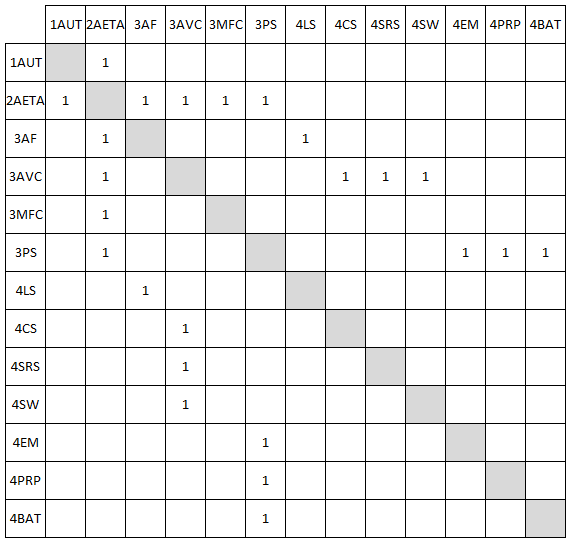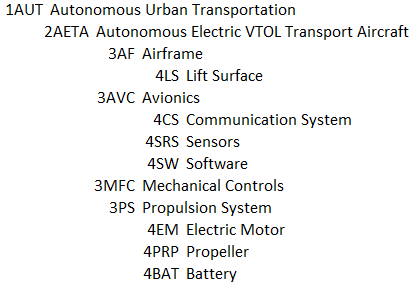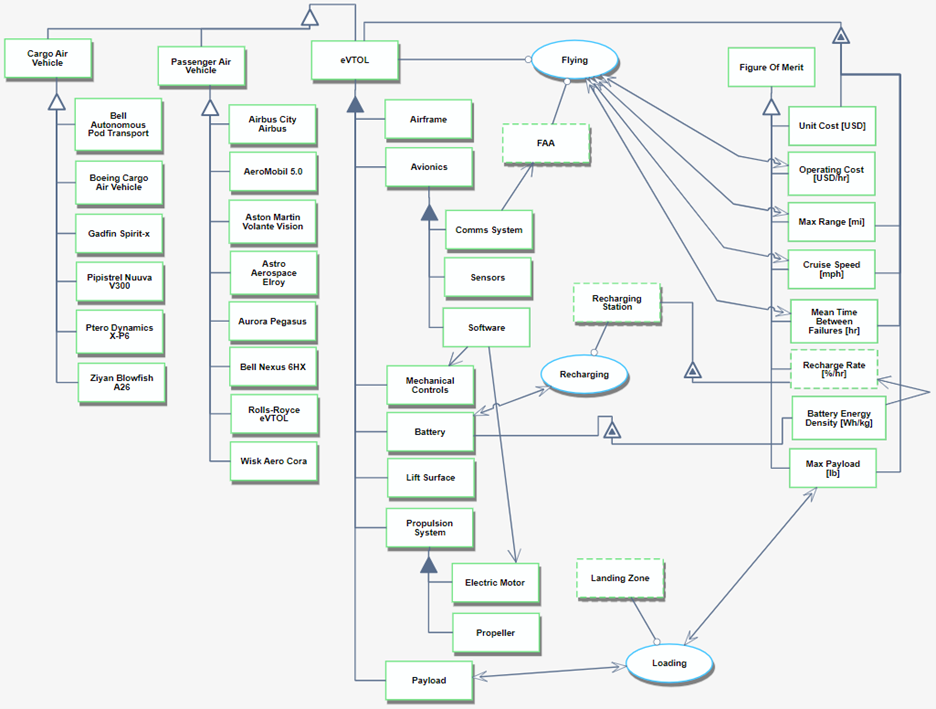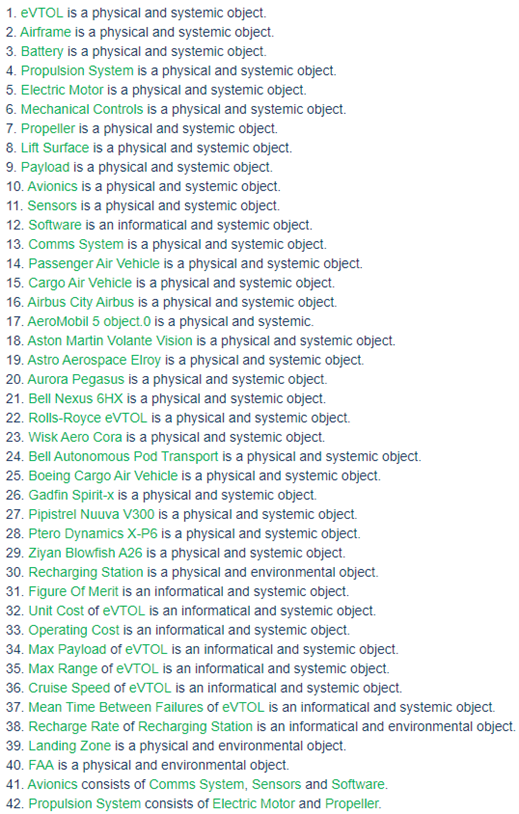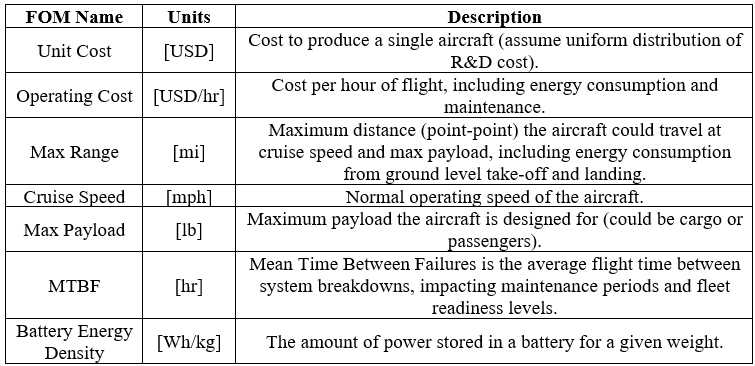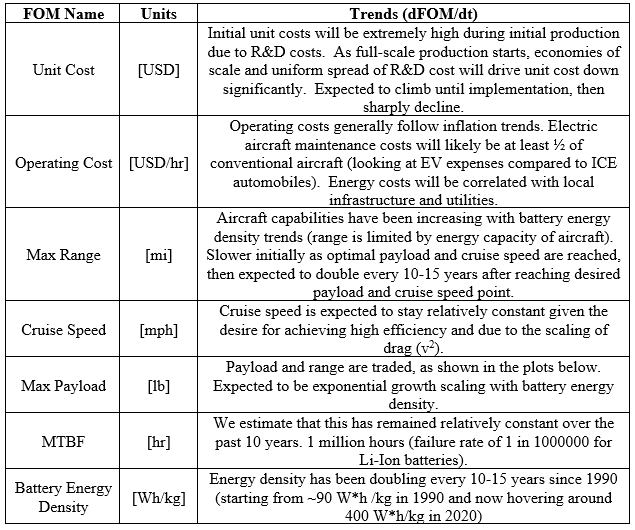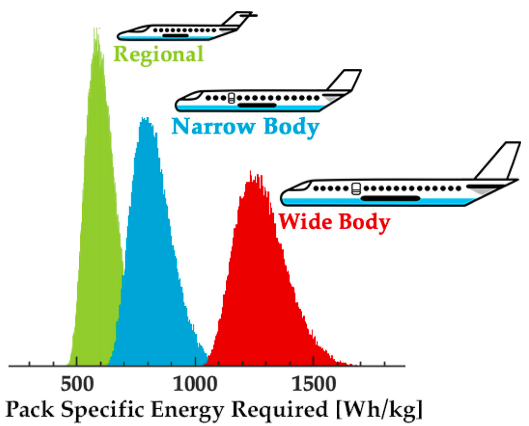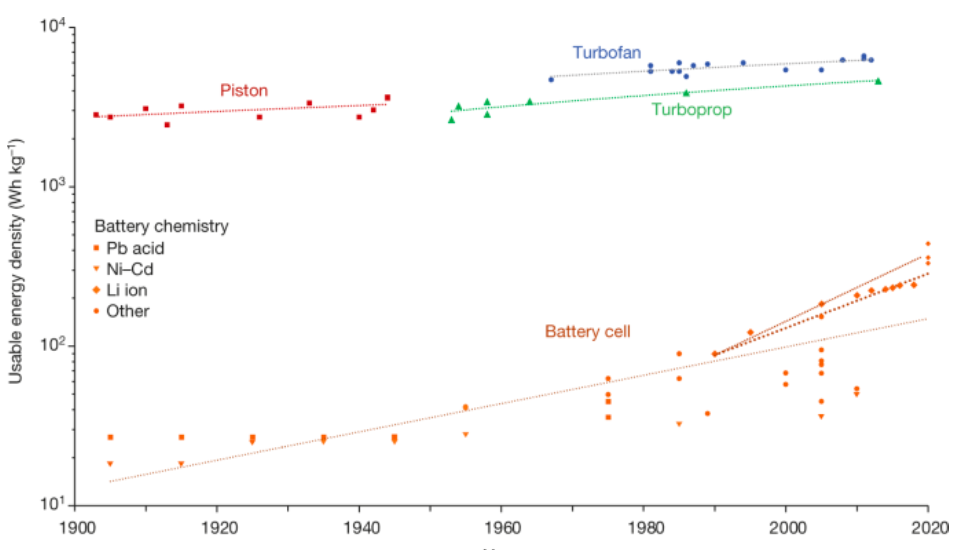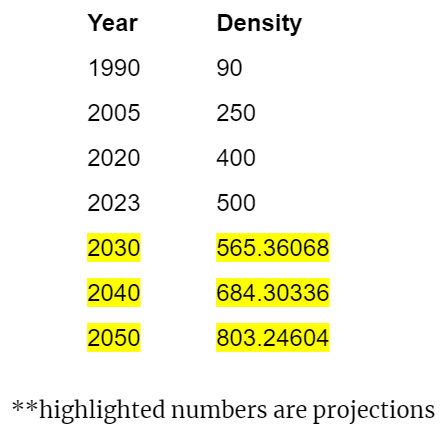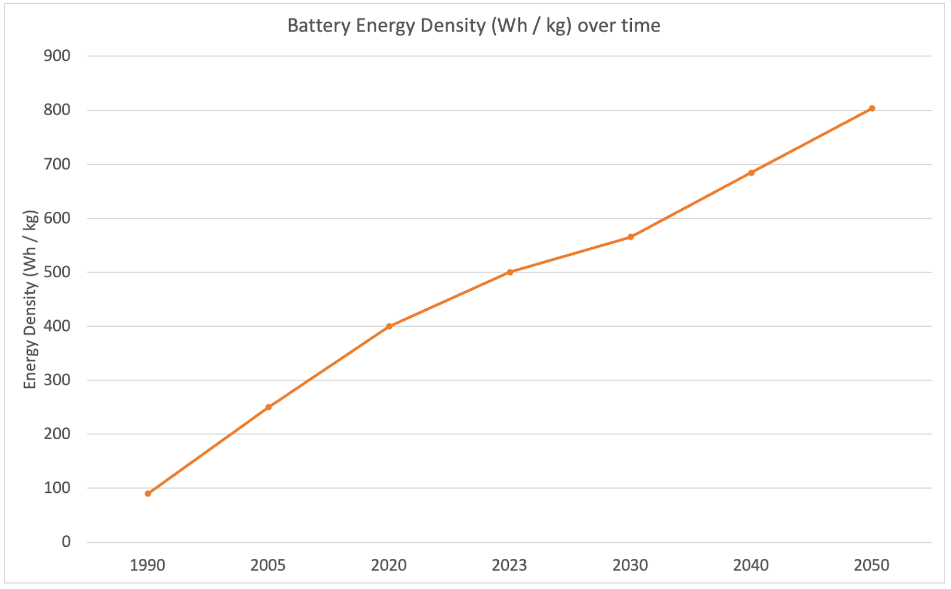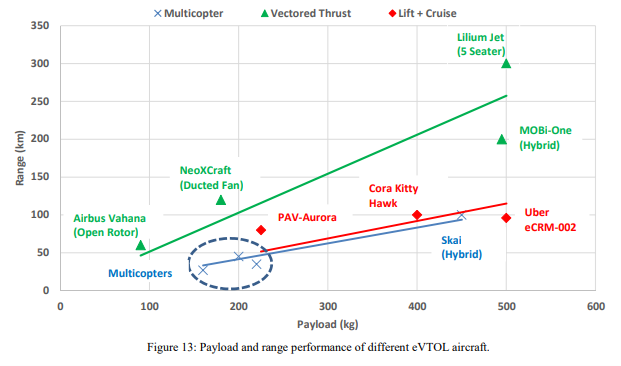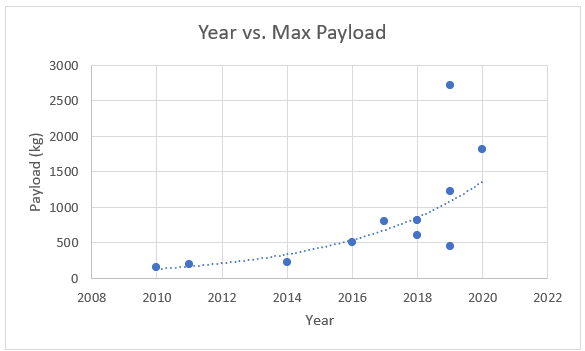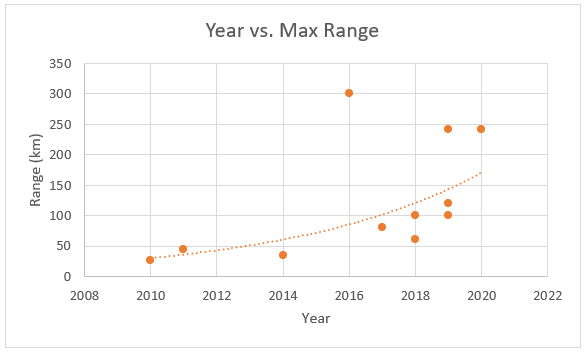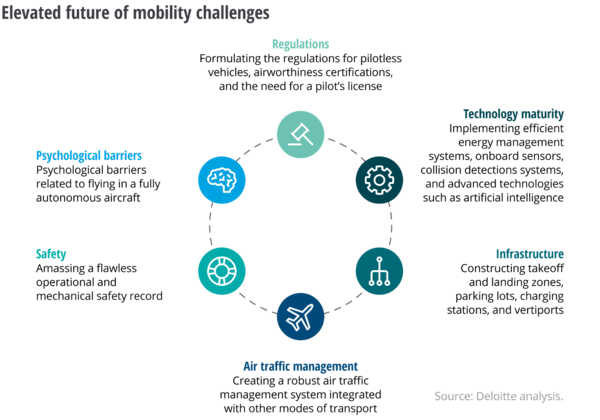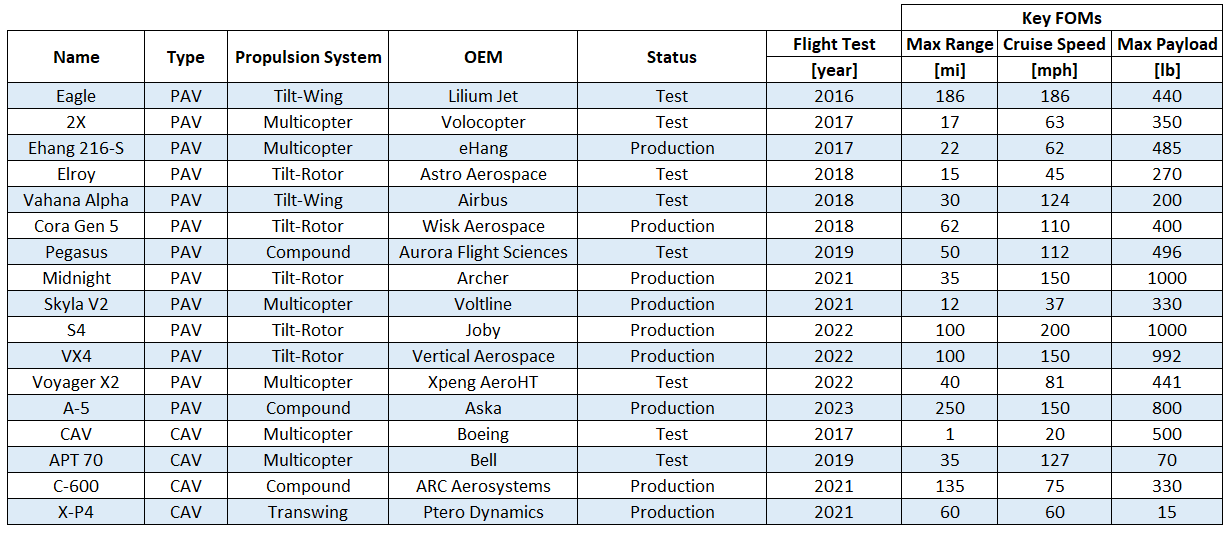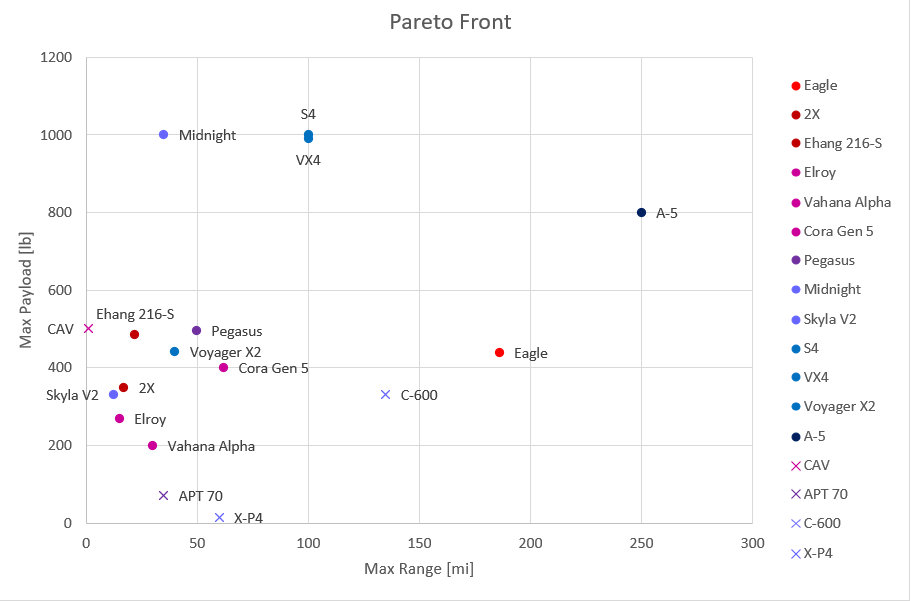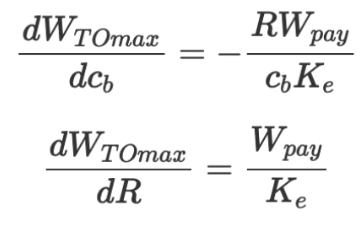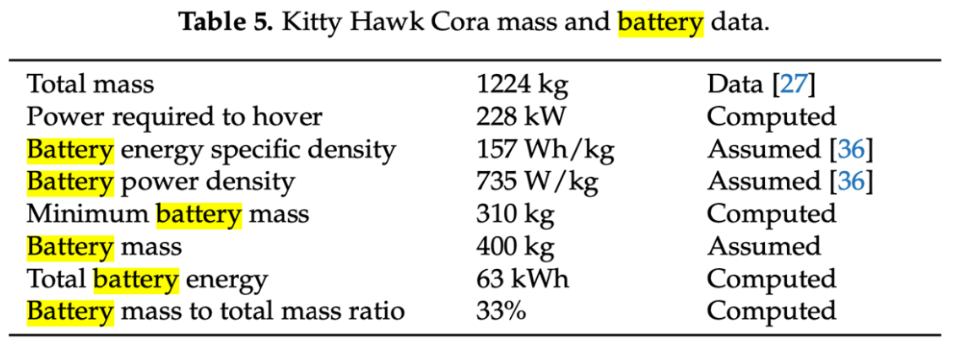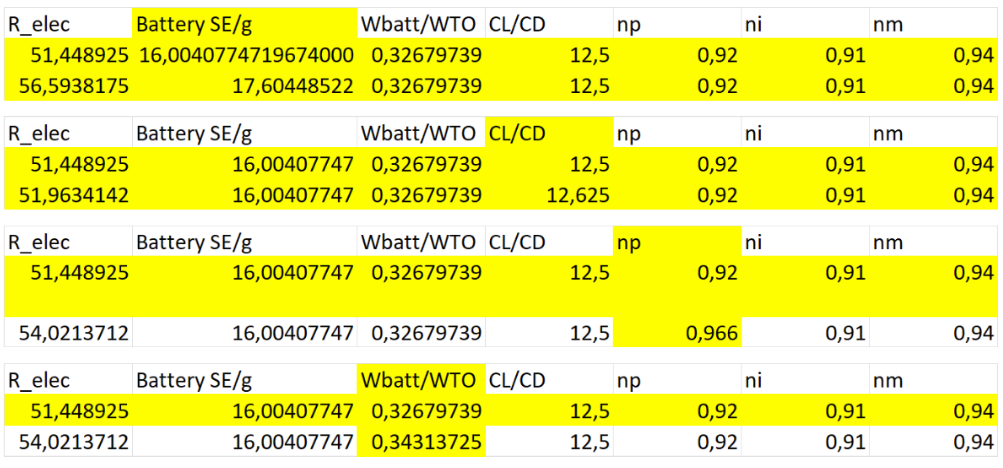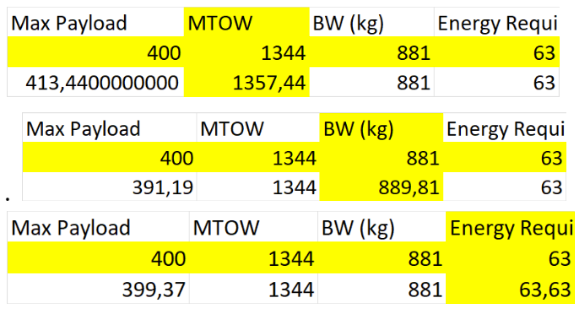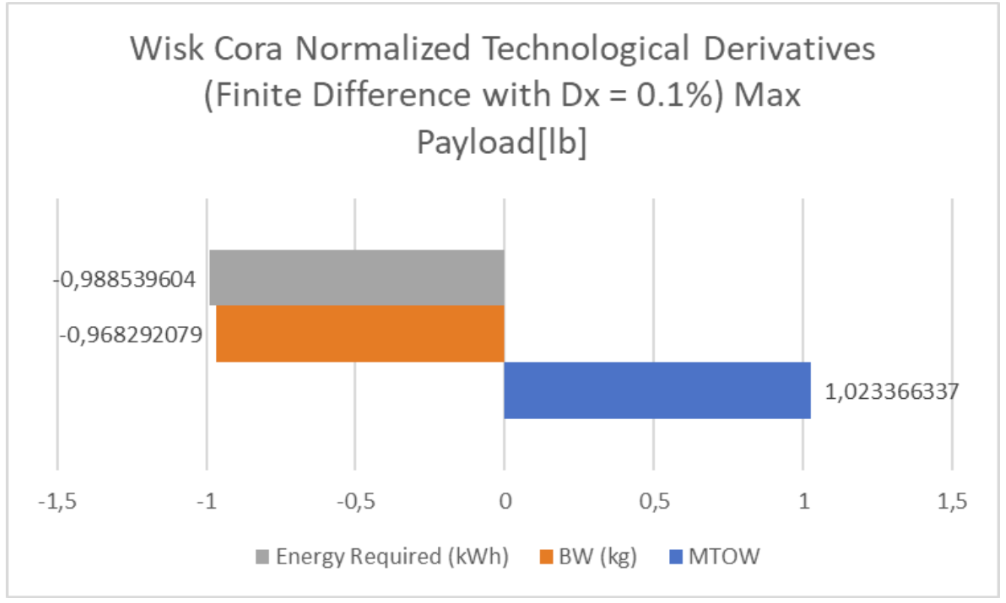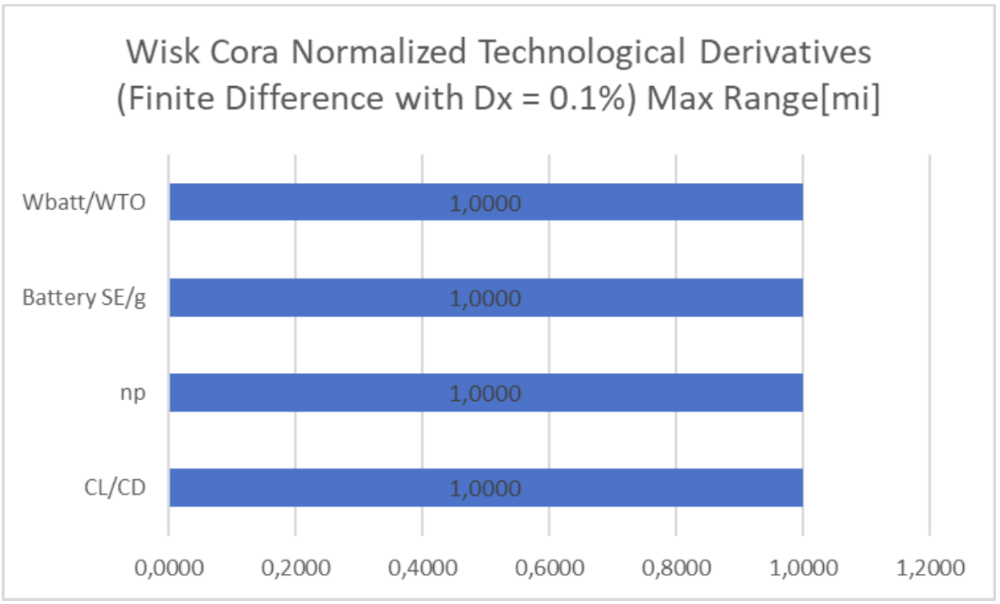Difference between revisions of "Autonomous ElectricVTOL Transport Aircraft"
| Line 61: | Line 61: | ||
Autonomous eVTOL transportation aircraft serve a large number of functions and, as such, can align to diverse strategic drivers. Cargo air vehicles can serve an increasingly time sensitive delivery industry, shorten the "last mile" delivery network for companies like Amazon, or simply reach previously geographically inaccessible locations for goods transportation (military or remote environments). Passenger air vehicles are expected to improve integration of urban environments, especially those heavily congested by ground vehicle traffic or geographic limitations. | Autonomous eVTOL transportation aircraft serve a large number of functions and, as such, can align to diverse strategic drivers. Cargo air vehicles can serve an increasingly time sensitive delivery industry, shorten the "last mile" delivery network for companies like Amazon, or simply reach previously geographically inaccessible locations for goods transportation (military or remote environments). Passenger air vehicles are expected to improve integration of urban environments, especially those heavily congested by ground vehicle traffic or geographic limitations. | ||
This technology has | This technology has five focus areas that must be developed to enable mass deployment and adoption. | ||
2. Battery Technology Maturity | |||
3. Infrastructure Development | |||
4. Air Traffic Management and Regulation Improvement | |||
5. Operational Safety and Psychological barrier | |||
{| class="wikitable" | |||
|- | |||
! Number !! Focus Area !! Primary Ownership !! Description | |||
|- | |||
| '''1''' || Aircraft Propulsion and Control Technology Maturity || Aircraft Manufacturers || This covers the development of the integrated air vehicle, combining electric propulsion systems with high quality producible aircraft. In addition, this covers propulsion system and flight control system development, which will be primary drivers of FOMs. | |||
|- | |||
| '''2''' || Battery Technology Maturity || Battery Manufacturers || This is working directly to improve battery energy density, which is a primary driver of aircraft capabilities. | |||
|- | |||
| '''3''' || Regulations || To develop low noise hover systems with lower disc loading in order to allow for the eVTOL to take off from various landing ports in urban areas. The reduced noise and disc loading will enable the construction of compact landing pads in buildings or courtyard without disrupting normal urban life. || The discloading of the aircraft severely impacts the noise level generated by the hover. The harrier jet generates 125 dB of noise when hovering at 100ft, whereas helicopters generate 108 dB at ground level. Reduction of these to 78 dB is required in order to achieve the desired noise level. Improved research in this area with different designs of the propulsion systems and noise dissipation can significantly reduce noise levels. '''This driver is currently aligned with the roadmap.''' | |||
|- | |||
| '''4''' || Infrastructure || To enable safe, efficient, and regulated Air Traffic Management systems to help eVTOLs navigate seamlessly in an urban environment. With 100s of eVTOLs buzzing above populated cities, the risk of potential crashes increases significantly. Unlike airports and helicopters, eVTOLs would be deployed in large quantities and the heliports would space out in the most populated areas. An advanced ATC system can increase operational efficiency safely || The current state of the art relies heavily on human intervention to manage Air Traffic. Switching to Level 5 Autonomous Navigation would improve the predictability of flight patterns of eVTOLs making it easier to automate the Air Traffic management with minimal human supervision '''This driver is currently aligned with the eVTOLs.''' | |||
|- | |||
| '''5''' || Air Traffic Management || To enable safe, efficient, and regulated Air Traffic Management systems to help eVTOLs navigate seamlessly in an urban environment. With 100s of eVTOLs buzzing above populated cities, the risk of potential crashes increases significantly. Unlike airports and helicopters, eVTOLs would be deployed in large quantities and the heliports would space out in the most populated areas. An advanced ATC system can increase operational efficiency safely || The current state of the art relies heavily on human intervention to manage Air Traffic. Switching to Level 5 Autonomous Navigation would improve the predictability of flight patterns of eVTOLs making it easier to automate the Air Traffic management with minimal human supervision '''This driver is currently aligned with the eVTOLs.''' | |||
|- | |||
| '''6''' || Operational Safety and Psychological Barriers || To remove the psychological barrier surrounding Urban Air Mobility and autonomous flying. To enable mass adoption of autonomous eVTOLs, the passengers need to be comfortable with giving up control to a machine. The decision making or the "moral machine" of the systems need to be state of the art to resolve conflicts in the case of unexpected malfunctions. Moreover, this decision might also involve the consideration of potential crashes in the urban environment making it harder for the residents to accept autonomous flying machines over their houses. || Numerous studies for the moral machine of self-driving cars with level 5 autonomy conducted apply to UAM as well. These decision-making principles govern the onboard AI to resolve conflicts in the decision making in an unexpected scenario like a bird strike, equipment malfunction. Numerous social experiments are required to perfect this moral machine to remove the psychological barrier in the potential passengers. '''This driver is currently NOT aligned with the eVTOLs.''' | |||
|} | |||
<br> | |||
Of all five different focus areas, traditional airframe manufacturers only | |||
One of the main benefits of eVTOLs is the integration of the heliports in the urban environment that reduces the CAPEX cost. As mentioned in the overview, eVTOLs can have various configurations for various advantages and this directly impacts the infrastructure around UAM. The improvements in the propulsion systems and the battery technology are the most important for the technology Maturity ensuring that our technology is as close to the Pareto Front as possible thus providing an edge over various the competitors in this domain. | One of the main benefits of eVTOLs is the integration of the heliports in the urban environment that reduces the CAPEX cost. As mentioned in the overview, eVTOLs can have various configurations for various advantages and this directly impacts the infrastructure around UAM. The improvements in the propulsion systems and the battery technology are the most important for the technology Maturity ensuring that our technology is as close to the Pareto Front as possible thus providing an edge over various the competitors in this domain. | ||
| Line 72: | Line 101: | ||
{| class="wikitable" | {| class="wikitable" | ||
|- | |- | ||
! Number !! Strategic Drivers !! Alignment targets | ! Number !! Focus Area !! Strategic Drivers !! Alignment targets | ||
|- | |||
| '''1''' || Airframe Technology Maturity || To develop hover and cruise configurations to lower the net cost to the passenger for intercity flights in a limited service radius. The design of the eVTOL itself should enable reduced CAPEX costs and OPEX costs for a flight over a limited radius. The current air transportation modes either result in high CAPEX (Airports) or high OPEX (Helicopters, multirotors) that drive the cost up. || This roadmap will target the technology selection that would address the need for high hover efficiency for take-off and landing and high cruise efficiency for covering higher distances. The state of the art technology of tilt rotors and tilt wing aircrafts seem to enable the use of a common propulsion system for hover and cruise, leveraging the best of both aircrafts and rotorcraft(conventional). '''This roadmap evaluates various configurations of eVTOLs and this driver is aligned with this roadmap.''' | |||
|- | |- | ||
| ''' | | '''2''' || Battery Technology Maturity || To target higher PAX capacities while keeping a balance with a decent range to enable cost effective transportation to surrounding cities, making the hub & spoke transportation model a reality. Efficient propulsion systems would increase the efficiency of the eVTOL creating room for more passengers or higher ranges. || The development of the Li-ion batteries with higher energy density is crucial to increased payload capacity of eVTOLs. THe Li-ion energy density has tripled since 2010 to 300Wh/Kg. To achieve a long range flight, a target of 500Wh/Kg is expected by 2025. The weight of the eVTOL itself plays a major role in this. Use of lighter materials like aluminum and carbon fiber are expected for the construction of the eVTOL. '''This driver is in alignment of the 2EVL roadmap''' | ||
|- | |- | ||
| ''' | | '''3''' || Regulations || To develop low noise hover systems with lower disc loading in order to allow for the eVTOL to take off from various landing ports in urban areas. The reduced noise and disc loading will enable the construction of compact landing pads in buildings or courtyard without disrupting normal urban life. || The discloading of the aircraft severely impacts the noise level generated by the hover. The harrier jet generates 125 dB of noise when hovering at 100ft, whereas helicopters generate 108 dB at ground level. Reduction of these to 78 dB is required in order to achieve the desired noise level. Improved research in this area with different designs of the propulsion systems and noise dissipation can significantly reduce noise levels. '''This driver is currently aligned with the roadmap.''' | ||
|- | |- | ||
| ''' | | '''4''' || Infrastructure || To enable safe, efficient, and regulated Air Traffic Management systems to help eVTOLs navigate seamlessly in an urban environment. With 100s of eVTOLs buzzing above populated cities, the risk of potential crashes increases significantly. Unlike airports and helicopters, eVTOLs would be deployed in large quantities and the heliports would space out in the most populated areas. An advanced ATC system can increase operational efficiency safely || The current state of the art relies heavily on human intervention to manage Air Traffic. Switching to Level 5 Autonomous Navigation would improve the predictability of flight patterns of eVTOLs making it easier to automate the Air Traffic management with minimal human supervision '''This driver is currently aligned with the eVTOLs.''' | ||
|- | |- | ||
| ''' | | '''5''' || Air Traffic Management || To enable safe, efficient, and regulated Air Traffic Management systems to help eVTOLs navigate seamlessly in an urban environment. With 100s of eVTOLs buzzing above populated cities, the risk of potential crashes increases significantly. Unlike airports and helicopters, eVTOLs would be deployed in large quantities and the heliports would space out in the most populated areas. An advanced ATC system can increase operational efficiency safely || The current state of the art relies heavily on human intervention to manage Air Traffic. Switching to Level 5 Autonomous Navigation would improve the predictability of flight patterns of eVTOLs making it easier to automate the Air Traffic management with minimal human supervision '''This driver is currently aligned with the eVTOLs.''' | ||
|- | |- | ||
| ''' | | '''6''' || Operational Safety and Psychological Barriers || To remove the psychological barrier surrounding Urban Air Mobility and autonomous flying. To enable mass adoption of autonomous eVTOLs, the passengers need to be comfortable with giving up control to a machine. The decision making or the "moral machine" of the systems need to be state of the art to resolve conflicts in the case of unexpected malfunctions. Moreover, this decision might also involve the consideration of potential crashes in the urban environment making it harder for the residents to accept autonomous flying machines over their houses. || Numerous studies for the moral machine of self-driving cars with level 5 autonomy conducted apply to UAM as well. These decision-making principles govern the onboard AI to resolve conflicts in the decision making in an unexpected scenario like a bird strike, equipment malfunction. Numerous social experiments are required to perfect this moral machine to remove the psychological barrier in the potential passengers. '''This driver is currently NOT aligned with the eVTOLs.''' | ||
|} | |} | ||
Revision as of 16:56, 2 November 2023
Autonomous Electric Vertical Take-off and Landing (eVTOL) Transport Aircraft
Roadmap Overview
Autonomous Electric Vertical Take-off and Landing (eVTOL) Transport Aircraft are a wide category of unpiloted, electrically powered aircraft for the purpose of transporting goods or organisms. They may fall under the Cargo Air Vehicle (CAV) or Passenger Air Vehicle (PAV) categories. The aircraft have relatively small footprints and are well suited for navigation in urban environments. They are currently in development by various companies ranging from traditional aerospace companies (Airbus and Boeing) to new competitors from different backgrounds (Amazon to Rolls-Royce) and widely believed to have a huge impact on the future of mobility. While individual components of the technology are well developed, the focus here is the assembly and integration of autonomy, which requires increased efficiency, increased reliability, improved infrastructure, and significant cost reductions from the current state.
Image Source: https://wisk.aero/aircraft/
DSM Allocation
This would be related to the following existing roadmaps: 2SEA, 2BEV, 2SPA, 2EVL, 3ESB, 3BAS.
The 2-AETA tree from the DSM shows it as a subste of autonomous urban transportation (1AUT). It consists of various major subsystems, including airframe (3AF), avionics (3AVC), mechanical controls (3MFC), and the propulsion system (3PS). Those subsystems require various component level technologies, including lift surface (4LS), communication system (4CS), sensors (4SRS), software (4SW), electric motor (4EM), propeller (4PRP), and battery (4BAT).
Roadmap Model using OPM
Figures of Merit (FOM)
Battery Energy Density FOM
We estimate that electric battery technology is currently slowing and nearing the stagnation point. Based on the current achievable energy densities of Li-ion batteries, we are at or near the theoretical limit unless there is a major breakthrough in solid-state technologies or non-conventional oxide chemistries. The maximum theoretical specific energy density for a max 4.2V battery is estimated to be between 380-460 Wh / kg. Current understanding of technology has the densest lithium-ion batteries generally hovering below 300 Watt hours per kilogram (Wh/kg); however a few companies (CATL and Amprius) claim batteries boasting a 500 Wh/kg density, which could potentially mean regional electric transport could become viable in the near future.
Lithium-ion batteries emerged onto the commercial market in the 1990s and since then, the energy density has been doubling every 10-15 years.
Payload and Range FOMs
Alignment with Company Strategic Drivers
Autonomous eVTOL transportation aircraft serve a large number of functions and, as such, can align to diverse strategic drivers. Cargo air vehicles can serve an increasingly time sensitive delivery industry, shorten the "last mile" delivery network for companies like Amazon, or simply reach previously geographically inaccessible locations for goods transportation (military or remote environments). Passenger air vehicles are expected to improve integration of urban environments, especially those heavily congested by ground vehicle traffic or geographic limitations.
This technology has five focus areas that must be developed to enable mass deployment and adoption.
2. Battery Technology Maturity
3. Infrastructure Development
4. Air Traffic Management and Regulation Improvement
5. Operational Safety and Psychological barrier
| Number | Focus Area | Primary Ownership | Description |
|---|---|---|---|
| 1 | Aircraft Propulsion and Control Technology Maturity | Aircraft Manufacturers | This covers the development of the integrated air vehicle, combining electric propulsion systems with high quality producible aircraft. In addition, this covers propulsion system and flight control system development, which will be primary drivers of FOMs. |
| 2 | Battery Technology Maturity | Battery Manufacturers | This is working directly to improve battery energy density, which is a primary driver of aircraft capabilities. |
| 3 | Regulations | To develop low noise hover systems with lower disc loading in order to allow for the eVTOL to take off from various landing ports in urban areas. The reduced noise and disc loading will enable the construction of compact landing pads in buildings or courtyard without disrupting normal urban life. | The discloading of the aircraft severely impacts the noise level generated by the hover. The harrier jet generates 125 dB of noise when hovering at 100ft, whereas helicopters generate 108 dB at ground level. Reduction of these to 78 dB is required in order to achieve the desired noise level. Improved research in this area with different designs of the propulsion systems and noise dissipation can significantly reduce noise levels. This driver is currently aligned with the roadmap. |
| 4 | Infrastructure | To enable safe, efficient, and regulated Air Traffic Management systems to help eVTOLs navigate seamlessly in an urban environment. With 100s of eVTOLs buzzing above populated cities, the risk of potential crashes increases significantly. Unlike airports and helicopters, eVTOLs would be deployed in large quantities and the heliports would space out in the most populated areas. An advanced ATC system can increase operational efficiency safely | The current state of the art relies heavily on human intervention to manage Air Traffic. Switching to Level 5 Autonomous Navigation would improve the predictability of flight patterns of eVTOLs making it easier to automate the Air Traffic management with minimal human supervision This driver is currently aligned with the eVTOLs. |
| 5 | Air Traffic Management | To enable safe, efficient, and regulated Air Traffic Management systems to help eVTOLs navigate seamlessly in an urban environment. With 100s of eVTOLs buzzing above populated cities, the risk of potential crashes increases significantly. Unlike airports and helicopters, eVTOLs would be deployed in large quantities and the heliports would space out in the most populated areas. An advanced ATC system can increase operational efficiency safely | The current state of the art relies heavily on human intervention to manage Air Traffic. Switching to Level 5 Autonomous Navigation would improve the predictability of flight patterns of eVTOLs making it easier to automate the Air Traffic management with minimal human supervision This driver is currently aligned with the eVTOLs. |
| 6 | Operational Safety and Psychological Barriers | To remove the psychological barrier surrounding Urban Air Mobility and autonomous flying. To enable mass adoption of autonomous eVTOLs, the passengers need to be comfortable with giving up control to a machine. The decision making or the "moral machine" of the systems need to be state of the art to resolve conflicts in the case of unexpected malfunctions. Moreover, this decision might also involve the consideration of potential crashes in the urban environment making it harder for the residents to accept autonomous flying machines over their houses. | Numerous studies for the moral machine of self-driving cars with level 5 autonomy conducted apply to UAM as well. These decision-making principles govern the onboard AI to resolve conflicts in the decision making in an unexpected scenario like a bird strike, equipment malfunction. Numerous social experiments are required to perfect this moral machine to remove the psychological barrier in the potential passengers. This driver is currently NOT aligned with the eVTOLs. |
Of all five different focus areas, traditional airframe manufacturers only
One of the main benefits of eVTOLs is the integration of the heliports in the urban environment that reduces the CAPEX cost. As mentioned in the overview, eVTOLs can have various configurations for various advantages and this directly impacts the infrastructure around UAM. The improvements in the propulsion systems and the battery technology are the most important for the technology Maturity ensuring that our technology is as close to the Pareto Front as possible thus providing an edge over various the competitors in this domain. The tight integration of UAM in the urban context also calls for improvements in ATC in order to enable safe operations of 100s eVTOLs operating over cities, this would more or less determine whether the UAM service can be permitted to operate. Added to this, noise reduction is another important aspect to improve the psychological barrier.
Listed below are the strategic drivers for the company, and the alignment targets of our roadmap with these drivers:
| Number | Focus Area | Strategic Drivers | Alignment targets |
|---|---|---|---|
| 1 | Airframe Technology Maturity | To develop hover and cruise configurations to lower the net cost to the passenger for intercity flights in a limited service radius. The design of the eVTOL itself should enable reduced CAPEX costs and OPEX costs for a flight over a limited radius. The current air transportation modes either result in high CAPEX (Airports) or high OPEX (Helicopters, multirotors) that drive the cost up. | This roadmap will target the technology selection that would address the need for high hover efficiency for take-off and landing and high cruise efficiency for covering higher distances. The state of the art technology of tilt rotors and tilt wing aircrafts seem to enable the use of a common propulsion system for hover and cruise, leveraging the best of both aircrafts and rotorcraft(conventional). This roadmap evaluates various configurations of eVTOLs and this driver is aligned with this roadmap. |
| 2 | Battery Technology Maturity | To target higher PAX capacities while keeping a balance with a decent range to enable cost effective transportation to surrounding cities, making the hub & spoke transportation model a reality. Efficient propulsion systems would increase the efficiency of the eVTOL creating room for more passengers or higher ranges. | The development of the Li-ion batteries with higher energy density is crucial to increased payload capacity of eVTOLs. THe Li-ion energy density has tripled since 2010 to 300Wh/Kg. To achieve a long range flight, a target of 500Wh/Kg is expected by 2025. The weight of the eVTOL itself plays a major role in this. Use of lighter materials like aluminum and carbon fiber are expected for the construction of the eVTOL. This driver is in alignment of the 2EVL roadmap |
| 3 | Regulations | To develop low noise hover systems with lower disc loading in order to allow for the eVTOL to take off from various landing ports in urban areas. The reduced noise and disc loading will enable the construction of compact landing pads in buildings or courtyard without disrupting normal urban life. | The discloading of the aircraft severely impacts the noise level generated by the hover. The harrier jet generates 125 dB of noise when hovering at 100ft, whereas helicopters generate 108 dB at ground level. Reduction of these to 78 dB is required in order to achieve the desired noise level. Improved research in this area with different designs of the propulsion systems and noise dissipation can significantly reduce noise levels. This driver is currently aligned with the roadmap. |
| 4 | Infrastructure | To enable safe, efficient, and regulated Air Traffic Management systems to help eVTOLs navigate seamlessly in an urban environment. With 100s of eVTOLs buzzing above populated cities, the risk of potential crashes increases significantly. Unlike airports and helicopters, eVTOLs would be deployed in large quantities and the heliports would space out in the most populated areas. An advanced ATC system can increase operational efficiency safely | The current state of the art relies heavily on human intervention to manage Air Traffic. Switching to Level 5 Autonomous Navigation would improve the predictability of flight patterns of eVTOLs making it easier to automate the Air Traffic management with minimal human supervision This driver is currently aligned with the eVTOLs. |
| 5 | Air Traffic Management | To enable safe, efficient, and regulated Air Traffic Management systems to help eVTOLs navigate seamlessly in an urban environment. With 100s of eVTOLs buzzing above populated cities, the risk of potential crashes increases significantly. Unlike airports and helicopters, eVTOLs would be deployed in large quantities and the heliports would space out in the most populated areas. An advanced ATC system can increase operational efficiency safely | The current state of the art relies heavily on human intervention to manage Air Traffic. Switching to Level 5 Autonomous Navigation would improve the predictability of flight patterns of eVTOLs making it easier to automate the Air Traffic management with minimal human supervision This driver is currently aligned with the eVTOLs. |
| 6 | Operational Safety and Psychological Barriers | To remove the psychological barrier surrounding Urban Air Mobility and autonomous flying. To enable mass adoption of autonomous eVTOLs, the passengers need to be comfortable with giving up control to a machine. The decision making or the "moral machine" of the systems need to be state of the art to resolve conflicts in the case of unexpected malfunctions. Moreover, this decision might also involve the consideration of potential crashes in the urban environment making it harder for the residents to accept autonomous flying machines over their houses. | Numerous studies for the moral machine of self-driving cars with level 5 autonomy conducted apply to UAM as well. These decision-making principles govern the onboard AI to resolve conflicts in the decision making in an unexpected scenario like a bird strike, equipment malfunction. Numerous social experiments are required to perfect this moral machine to remove the psychological barrier in the potential passengers. This driver is currently NOT aligned with the eVTOLs. |
adoptors
Currently, there are a number of companies who are competing to be first to market, these are the pioneers who are paving the way through the initial barriers discussed above
Positioning of Company vs. Competition
The image gallery below depicts various industry leading eVTOL aircraft that fit this category and have successfully completed first flight.
The table and graph below compiles publicly available data on the aircraft and some key Figures of Merit. The table consists of a large variety of aircraft, including different propulsion types and cargo/passenger aircraft.
Note, many critical FOMs are not publicly available for these aircraft. Consequently, full technology development cannot be mapped. For example, the Voltline Skyla-V2 sacrifices performance for cost advantage (based on observable airframe structure) - this is not captured for the pareto front because unit cost has not been defined yet. In addition, the values provided are released in media, but not validated through test. By limiting scope to only tested aircraft, and not conceptual mockups, the reporting error should be minimized, but will still be present without a reliable means of confirming provided data.
In the graph below, color shading and marker type are used to indicate year of first flight and type of aircraft, respectively.
Note: No lines are drawn to represent the pareto front because the lack of precision in publicly available data may mislead designers.
Technical Model: Morphological Matrix and Tradespace
We are restricting the analysis to the FOMs of Max Range[mi] and Max Payload [lbs].
For our FOM Max. Range [mi] we can use the Breguet Range Equation and take partial derivatives to determine the sensitivity analysis for weight.
Breguet Range equation adapted for eVTOLs:
- CLCD is the lift to drag ratio
- cb is the battery specific energy (energy / mass)
- Wbatt,WTO are the battery weight, takeoff weight
- ηi,ηm,ηp are the inverter, motor, and propulsive efficiency
- g is the gravitational constant
We are interested in how the weight of an aircraft depends on the specific energy (energy mass density) of the battery, which is falling over time. We also care about the cost of increasing the range requirement of an aircraft (longer range aircraft need to be heavier):
For these FOMs we will take the (Wisk) Kitty Hawk Cora as a particular design vector. According to our simulations in the Appendix, we come with following tornado chart.
For Max Range:
For Max Payload:
Key Publications and Patents
Patents:
1. System And Method For Monitoring And Mitigating Pilot Actions In An Electric Aircraft - US 11801944 B1, 2023-10-31. This patent patents at a high level, a system for monitoring and mitigating pilot actions in an electric aircraft. It includes a computing device configured to detect at least a first flight datum and determine a current flight context as a function of that at least a first flight datum. It includes the computing device receiving a pilot input command, identifying a triggering event as a function of the current flight context and the pilot input command, and performing a mitigating response.
2. METHOD, APPARATUS AND COMPUTER PROGRAM TO DETECT DANGEROUS OBJECT FOR AERIAL VEHICLE - US 20230343230 A1 - 2023-10-26. This patent is about a method of detecting a dangerous object for an aerial vehicle. It sets an object detection area in air in which the aerial vehicle is in flight using a first sensor, a second sensor, and a third sensor; detecting an object in the set object detection area; generating detailed object information on the detected object; and determining whether the detected object is the dangerous object based on the generated detailed object information.
Papers:
1. Sarkar et. al., “A Data-Driven Approach for Performance Evaluation of Autonomous eVTOLs”, 2022. In this paper, a data-driven techniques to evaluate the performance of novel eVTOL configurations for executing autonomous missions in UAM environments is investigated. They considered real-world constraints to generate databases to be used by the proposed data-driven techniques.
2. Bauranov and J. Rakas, "Urban air mobility and manned eVTOLs: safety implications," 2019 IEEE/AIAA 38th Digital Avionics Systems Conference (DASC), San Diego, CA, USA, 2019. This paper explores the risks associated with manned eVTOLs, and the impact of automation system failures on pilot workload and flight safety by using Bayesian Belief Network.
3. X. Yang and P. Wei, "Autonomous Free Flight Operations in Urban Air Mobility With Computational Guidance and Collision Avoidance," in IEEE Transactions on Intelligent Transportation Systems, vol. 22, no. 9, pp. 5962-5975, Sept. 2021. In order to enable safe and efficient autonomous on-demand free flight operations in UAM, a computational guidance algorithm with collision avoidance capability is designed and analyzed. The approach proposed in this paper is to formulate this problem as a Markov Decision Process and solve it using an online algorithm Monte Carlo Tree Search.
References
2. https://www.eucass.eu/doi/EUCASS2022-7362.pdf
3. https://www.nature.com/articles/s41586-021-04139-1
5. https://batteryuniversity.com/article/bu-304a-safety-concerns-with-li-ion

